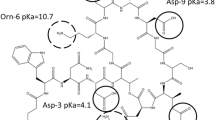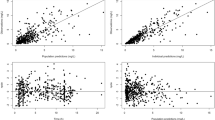Summary
The pharmacokinetic data of sisomicin, a new aminoglycoside antibiotic, were studied in ten normal subjects and in 24 uremic patients with various degrees of renal insufficiency. All subjects received a single dose of 1 mg/kg intramuscularly. Serum and urine levels were determined using a modification of the agar diffusion method with Bacillus subtilis as test organism. In normal subjects, the mean peak level was 4.54 ± 0.80 mcg/ml and the serum half-life (t/2) 2.27 ± 0.22 h. The apparent volume of distribution was 14.5 ± 2.3 1/1.73 m2, i.e. 22.7 ± 3.2% of body weight. 85.2 % ± 9.5 % of the injected dose was excreted in the urine during the 24 hours following injection. Renal clearance was 67.0 ± 14.9 ml/min/1.73 m2, i.e. 54.4 % ± 10.2 % of creatinine clearance (Ccr). In uraemic patients, the mean peak level was between 5.01 ± 0.65 and 5.59 ± 1.17 mcg/ml. We observed a very sharp increase in t/2 when creatinine clearance fell below 30 ml/min. Compared to 2.27 h in normal subjects, t/2 was 8 h in patients with 20<Ccr<80 ml/min (Group I), 22.61 h in patients with 5<Ccr<20 ml/min (Group II) and 56.98 h in patients with very poor renal function (Ccr<5 ml/min) (Group III). The urinary excretion of sisomicin diminished as the renal function decreased: 70 % of the injected dose in Group I and 44 % in Group II was excreted during the 48 hours following injection. In haemodialysed patients, 27.8–53 % of the sisomicin was extracted during a six hour dialysis session. On the basis of these pharmacokinetic data, it is possible to establish dosage schedules adapted to the degree of renal impairment.
Zusammenfassung
Die Pharmakokinetik des Sisomicin, eines neuen Aminoglykosids, wurde bei 10 nierengesunden Probanden und 24 urämischen Patienten mit unterschiedlich stark eingeschränkter Nierenfunktion untersucht. Alle erhielten eine Einzeldosis von 1 mg/kg intramuskulär. Serum- und Harnkonzentrationen wurden mit einem modifizierten Agardiffusionstest unter Verwendung von Bacillus subtilis bestimmt. Bei den Probanden lag der durchschnittliche Spitzenspiegel bei 4,54 ± 0,8 mcg/ml und die Halbwertszeit (t/2) im Serum betrug 2,27 ± 0,22 h. Das Verteilungsvolumen war 14,5 ± 2,3 1/1,73 m2, d. h. 22,7 ± 3,2% des Körpergewichts. 85,2% ± 9,5% derinjizierten Dosis wurde während der 24 Stundenperiode nach der Injektion mit dem Harn ausgeschieden. Die Nierenclearance betrug 67,0 ± 14,9 ml/min/1,732, d. h. 54,4% ± 10,2% der Kreatinin-Clearance (Ccr). Bei den urämischen Patienten lag der durchschnittliche Spitzenspiegel zwischen 5,01 ± 0,65 und 5,59 ± 1,17 mcg/ml t/2 stieg rasch an, sobald die Kreatinin-Clearance unter 30 ml/min fiel. Verglichen mit den 2,27 h bei normaler Nierenfunktion lag t/2 bei 8 h für Patienten mit 20<Ccr<80 ml (Gruppe I), bei 22,61 h für Patienten mit 5<Ccr<20 ml/min (Gruppe II) und bei 56,98 h für Patienten mit sehr schlechter Nierenfunktion (Ccr<5 ml/min) (Gruppe III). Die Sisomicin-Ausscheidung mit dem Harn sank mit Verschlechterung der Nierenfunktion ab: 70 % der verabreichten Dosis in Gruppe I und 44 % in Gruppe II wurden innerhalb von 48 Std. nach der Injektion ausgeschieden. Bei hämodialysierten Patienten wurden während 6 Stunden Dialyse 27,8–53 % des Sisomicins eliminiert. Nach diesen pharmakokinetischen Daten können die Dosierungsempfehlungen an die Nierenfunktion angepaßt werden.
Similar content being viewed by others
Literature
Bonsnes, R. W., Tausky, H. H. A colorimetric determination of creatinine by the JAFFE reaction J. Biol. Chem. 158 (1945) 581.
Chabbert, Y, A., Boulingre, A. Modifications pratiques concernant le dosage des antibiotiques en clinique. Rev. Franc. Etud. Clin. Biol. 2 (1957) 636–640.
Crowe, C. C., Sanders, E. Sisomicin: Evaluation in vitro and comparaison with gentamicin and tobramycin. Antimicrob. Ag. Chemother. 3 (1973) 24–28.
Dettli, L. Drug dosage in patients with renal disease. Clin. Pharm. Therap. 16 (1974) 274–280.
Dost, F. H. Grundlagen der Pharmakokinetik, S. 36, 238, 275, 311. Thieme, Stuttgart 1963.
Grove, D. C., Randall, W. A. Assay methods of antibiotics: A laboratory manual. Medical encyclopedia, New York 1955.
Humbert, G., Fillastre, J. P., Daufresne, M. F., Dubois, D., Leroy, A. Study of the serum half life of lividomycin in uraemic patients. Curr. Ther. Res. 16 (1974) 232–238.
Klastersky, J., Hensgens, L., Gerard, M. Daneau, J. Sisomicin: Bacteriological and clinical evaluation. J. Clin. Pharmacol. 15 (1975) 252–261.
Lode, H., Kemmerich, B. K., Köppe, P. Comparative clinical pharmacology of gentamicin, sisomicin and tobramycin. Antimicrob. Ag. Chemother. 8 (1975) 396–401.
McHenry, M. C., Gavan, T. L., Gifford, R. W., Geurlink, N. A., van Ommen, R. A., Town, M. A., Wagner, J. G. Gentamicin dosages for renal insufficiency. Adjustments based on endogenous creatinine clearance and serum creatinine concentration. Ann. Intern. Med. 74 (1971) 192–197.
Oksenhendler, G.: Etude pharmacocinétique d'un nouvel antibiotique du groupe des aminosides: le BB-K8 ou Amikacine chez les sujets normaux et chez les insuffisants rénaux chroniques. Thèse, Médecine, Rouen 1975.
Rodriguez, V., Bodey, G. P., Valdivieso, M., Feld, R. Clinical pharmacology of sisomicin. Antimicrob. Ag. Chemother. 7 (1975) 38–41.
Spring, P. Calculation of drug dosage regimens in patients with renal disease: A new nomographic method. Intern. J. clin. Pharmac. Bioph. 11 (1975) 76–80.
Wagman, G. H., Testa, R. T., Marquez, J. A. Antibiotic 6640 II fermentation, isolation and properties. J. Antibiot. 23 (1970) 55–558.
Waitz, J. A., Moss, E. L., Drube, C. G., Weinstein, M. J. Comparative activity of sisomicin, gentamicin, kanamycin and tobramycin. Antimicrob. Ag. Chemother. 2 (1972) 431–437.
Waitz, J. A., Moss, E. L., Oden, E. M., Weinstein, M. J. Antibiotic 6640 III Biological studies with antibiotic 6640, a new broad spectrum aminoglycoside antibiotic. J. Antibiot. 23 (1970) 559–565.
Weinstein, M. J., Marquez, J. A., Testa, R. T., Wagman, G. H., Oden, E. M., Waitz, J. A. Antibiotic 6640, a new micromonospora produced aminoglycoside antibiotic. J. Antibiot. 23 (1970) 551–554.
Author information
Authors and Affiliations
Rights and permissions
About this article
Cite this article
Humbert, G., Fillastre, J.P., Leroy, A. et al. Pharmacokinetics of sisomicin in the presence of normal and impaired renal function. Infection 4 (Suppl 4), S393–S402 (1976). https://doi.org/10.1007/BF01646971
Issue Date:
DOI: https://doi.org/10.1007/BF01646971




